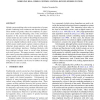Free Online Productivity Tools
i2Speak
i2Symbol
i2OCR
iTex2Img
iWeb2Print
iWeb2Shot
i2Type
iPdf2Split
iPdf2Merge
i2Bopomofo
i2Arabic
i2Style
i2Image
i2PDF
iLatex2Rtf
Sci2ools
WSC
2004
2004
Modeling Real-World Control Systems: Beyond Hybrid Systems
Hybrid system modeling refers to the construction of system models combining both continuous and discrete dynamics. These models can greatly reduce the complexity of a phystem model by abstracting some of the continuous dynamics of the system into discrete dynamics. Hybrid system models are also useful for describing the interaction between physical processes and computational processes, such as in a digital feedback control system. Unfortunately, hybrid system models poorly capture common software architecture design patterns, such as threads, mobile code, safety, and hardware interfaces. Dealing effectively with these practical software issues is crucial when designing real-world systems. This paper presents a model of a complex control system that combines continuous-state physical system models with rich discrete-state software models in a disciplined fashion. We show how expressive modeling using multiple semantics can be used to address the design difficulties in such a system.
| Added | 31 Oct 2010 |
| Updated | 31 Oct 2010 |
| Type | Conference |
| Year | 2004 |
| Where | WSC |
| Authors | Stephen Neuendorffer |
Comments (0)

